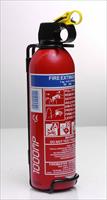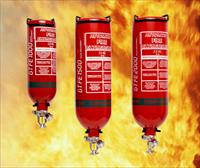Fire extinguishers at sea
Fire extinguishers
Everyone should be aware of the location of the fire extinguishers fitted to the vessel and how to use them.
There should be as a minimum:
- One in each cabin, near the exit
- A Fire Blanket near the cooker
- An automatic gas extinguisher in the engine compartment
- 2 buckets with lanyards (lots of water outside!), strong handles are required
- If possible another large extinguisher in the cockpit locker
Extinguishers come in different types, each have limitations;
Water
Can not be used on oil or electrical fires and there is plenty of water around, so these are not often found on yachts.
Most fires I have experienced on yachts have been minor incidents caused by things like tea towels falling on the cooker or in one case a crew member landing on the cooker in a gale and catching their waterproofs alight.
All these incidents were dealt with by the quick application of plenty of sea water from a bucket, if not dealt with rapidly any fire on a small craft can quickly become a major problem.
Dry Powder

Can be used on most fires but are very messy. The last time I was involved in a fire on a yacht, we used 6 powder extinguishers in a few minutes. We found that the dust was lifted by the heat of the fire and quickly made breathing below difficult.
Foam
Can be used on most fires on a yacht.
Gas
CO2, GTFE or Halotron are ideal in an engine compartment, but CO2 extinguishers will need a manual operation system and because you do not normally want to open the engine compartment to access a fire an automatic system is best.

If there is no extinguisher in the engine compartment, a hole with a cover should be made into the engine area so that a fire extinguisher with a flexible hose can be discharged over the engine if required.
Do not forget to protect the area around a generator if you have one fitted.
On large vessels with walk in engine rooms, be aware that the gas extinguishers operate by replacing the oxygen in the atmosphere, you do not want to be in the room when the fire suppression system starts up! If this type of system has been deployed, the space should only be entered by people wearing breathing apparatus, or on professional advice from ashore.
Electrical, fuel and gas isolators
In the event of a fire, one of the first tasks should be to isolate sources of fuel and ignition. It is vital that everyone know how to isolate the gas, fuel and electric supplies, if this is done quickly most fires will never develop to a major problem.
A major factor in gas safety is for the gas supply to be isolated at the bottle when the cooker is finished with. It is common for the gas to be turned off at the cut off switch beside the cooker when the cooking is finished, but the danger with this system is that if a leak develops between this cut off switch and the gas bottle, gas will still leak in to the bilge. If the gas alarm is not activated because the sensor is in a different compartment there is a risk of an explosion when the engine is started or electrical equipment is used (MAIB Report on gas explosion).
It is not always convenient to turn the gas off at the bottle but if an electrical cut off is fitted it can make it easy to keep good gas safety discipline.
All vessels with gas using equipment must have a Gas Alarm, if it activates the gas should be turned off at the bottle, no electrical equipment should be turned on or off to prevent sparks. To remove the gas, the vessel needs to be ventilated thoroughly everywhere, including the bilge area. The location of a gas leak may be detected by spreading soapy water on the piping or joints of the gas supply system.
Gas AlarmOne challenge I have experienced several times with gas alarms is that they can activate accidentally, this always seems to happen in the middle of the night in a gale, the result is that it is difficult to find what the problem is. I now carry a portable gas detector so I have a back up system when a gas alarm goes off, if the alarm activates, it is easy to check the vessel's compartments with a hand held detector.
A common fitting on motor vessels is ventilation fans that are started up for a few minutes prior to starting the engines, the fans blow through the engine and bilge space to remove any explosive gasses prior to the pressing the starter switch which produces electrical sparks. This is something that is rarely fitted on sailing boats but would be a valuable safety measure to have installed if possible.
Petrol
Don't use petrol on a boat! If you carry it for your outboard, keep the quantities to the minimum and try to store it on deck or in a locker that drains over the side of the vessel so that if there is a leak the petrol does not cause an explosion.
Seacocks
If there is a fire in the engine compartment, any pipes for the supply of cooling water or any other fittings that are connected to seacocks may be melted by the heat. To reduce this risk, any pipes in the engine compartment should be lagged with fire retardent materials, there should also be a means of closing any seacocks remotely so that if the piping does melt, the seacocks can be closed with out having to open the engine area and let oxygen in.
Save money ordering your safety equipment online.
Sailtrain.co.uk is free to use, but if you feel you would like to contribute to the running and development costs you can donate via Paypal:
Additional Resources:

